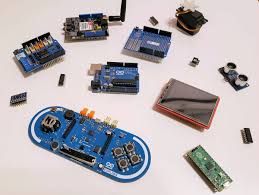 Arduino is an open-source electronics platform that has gained widespread popularity for its ease of use and versatility in prototyping and building electronic projects. It consists of both hardware and software components designed to make it accessible for beginners and advanced users alike.
Arduino is an open-source electronics platform that has gained widespread popularity for its ease of use and versatility in prototyping and building electronic projects. It consists of both hardware and software components designed to make it accessible for beginners and advanced users alike.
The Arduino programming language is an implementation of Wiring, a similar physical computing platform, which is based on the Processing multimedia programming environment. The Arduino’s designers sought to provide an inexpensive and easy way for hobbyists, students, and professionals to create devices that interact with their environment using sensors and actuators. Common examples for beginner hobbyists include simple robots, thermostats and motion detectors. It comes with a simple integrated development environment (IDE) that runs on regular personal computers and allows users to write programs for Arduino using C or C++.
Arduino Hardware:
-
 Microcontroller Boards: Arduino boards are at the core of the platform. They come in various models, but they all include a microcontroller unit (MCU) at their heart. The most commonly used MCU on Arduino boards is the ATmega series from Atmel (now a part of Microchip Technology).
Microcontroller Boards: Arduino boards are at the core of the platform. They come in various models, but they all include a microcontroller unit (MCU) at their heart. The most commonly used MCU on Arduino boards is the ATmega series from Atmel (now a part of Microchip Technology). -
Input and Output Pins: Arduino boards feature a set of digital input/output pins (GPIO) that can be used to connect sensors, LEDs, motors, and other components. They also have analog input pins for reading analog sensors.
-
Power Supply: Arduino boards can be powered via USB, an external power supply, or a battery, depending on the model. Some boards have built-in voltage regulators for different voltage requirements.
-
Connectivity: Many Arduino boards come with USB connectivity for programming and communication with a computer. Some have built-in Wi-Fi, Bluetooth, or Ethernet capabilities for IoT (Internet of Things) projects.
-
Shields: Arduino shields are add-on boards that can be stacked on top of an Arduino to provide additional functionality. There are shields for GPS, motor control, displays, and more.
Arduino Software:
-
Arduino IDE: The Arduino Integrated Development Environment (IDE) is an open-source software application used to write, compile, and upload code to Arduino boards. It uses a simplified version of C/C++ to create programs, known as "sketches."
-
Arduino Libraries: A rich library of pre-written code is available to make it easier to work with various components and modules. Users can extend these libraries or create their own.
Key Features and Uses:
-
Educational Tool: Arduino is widely used in educational settings to teach electronics, programming, and robotics. It's an excellent platform for students and beginners to learn about the basics of electronics and coding.
-
Rapid Prototyping: Arduino is a favorite among makers, tinkerers, and engineers for quickly prototyping and testing electronic projects. Its simplicity and vast community support make it ideal for iterating on ideas.
-
DIY Projects: Arduino can be used to create a wide range of DIY projects, such as home automation systems, weather stations, robot vehicles, interactive art installations, and more.
-
IoT Applications: Arduino's ability to connect to the internet and interact with sensors and actuators makes it suitable for IoT applications. It can be used for creating smart home devices and monitoring systems.
-
Accessibility: Arduino's open-source nature allows users to examine and modify the hardware and software. Users are free to use, adapt, and distribute their creations based on Arduino.
Arduino has played a significant role in making electronics and programming accessible to a broader audience. Its user-friendly approach and the strong community that has grown around it have contributed to its widespread adoption in the DIY and maker communities, as well as in educational and professional environments.
Featured Products
| A000073 | Arduino UNO SMD REV3 Board |